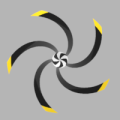Buckling Examples
I wanted to try out CCX 2.16. So following a previous forum post, I explored buckling. I found solid elements worked a lot better than shell elements. It solves much faster and the results look a lot better. It also has the advantage of letting you refine the mesh in different areas, by using bonded contact. For this example it looks like a buckling safety factor of 8 is a good choice. Some interesting things about CCX. You can solve past yield, with the nonlinear solver. Seems like it will converge up to the buckling load factor. After that, it won't converge, but you can see the displacement post buckling. I find that the most interesting thing to look at. The shell model, on my laptop, takes hours to solve that case. With the solid model, it solves in under and hour. So a big difference in solve time. The buckling modes, also look a lot better with the solid model. I had to clear the results, because the files were too big to upload. So you'll have to re-solve them. I did find, it's not a good idea to solve all configs at the same time. You can't see the nonlinear convergence graphs. Since it can take hours to solve the post buckling case, it's better to solve one config at a time. I used the Pardiso version of CCX with two cores. It works really well. Much faster than the regular version of CCX. You have to install the Intel MKL to use the Pardiso version of CCX. There's a different thread on the forum, that talks about how to install the Intel MKL, and get CCX Pardiso version running. It's definitely worth the time. You make it back up with much faster solve times and the ability to use multiple cores, which it does very well at. Lastly, I found for the shell model tet elements worked better than quad elements, for some reason.




Howdy, Stranger!
It looks like you're new here. If you want to get involved, click one of these buttons!


Comments